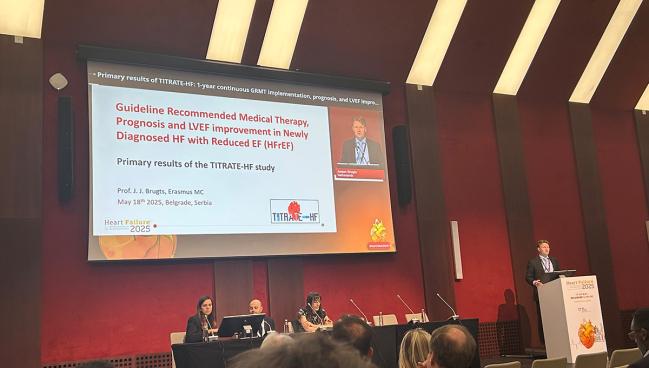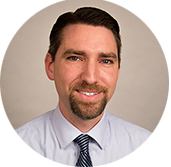TITRATE-HF: Use of GDMT for HF Is Getting Better but Still Not Ideal
The observed treatment rates, which “absolutely can go higher,” wouldn’t be acceptable for serious cancers, Stephen Greene says.

BELGRADE, Serbia—It is possible to get a high proportion of patients who have newly diagnosed heart failure with reduced ejection fraction (HFrEF) on all four pillars of guideline-directed medical therapy (GDMT), although there remains room for additional improvements, according to findings from the Dutch TITRATE-HF registry.
Nearly half of patients were on quadruple therapy with a renin-angiotensin-aldosterone-system (RAAS) inhibitor, beta-blocker, mineralocorticoid receptor antagonist (MRA), and sodium-glucose cotransporter 2 (SGLT2) inhibitor within the first 6. By 1 year, nearly two-thirds had achieved that goal.
J. J. Brugts, MD, PhD (Erasmus MC, Rotterdam, the Netherlands), reported the data here at the European Society of Cardiology’s Heart Failure 2025 congress.
There was little change in the proportion of patients on all four drugs after the first few months, however, indicating there is still an opportunity to get more patients on these critical medications, he indicated, noting, too, the importance of using recommended doses. Patients achieving at least 50% of the recommended doses saw greater gains in left ventricular ejection fraction.
“The current study shows that initiation of foundational therapy within 6 weeks is feasible in [the] real world and complements the data of STRONG-HF,” Brugts said during his presentation. “I think a proactive and continuous effort for optimizing GDMT, especially beyond that initial phase of the first 2 months, is essential for further implementation.”
Stephen Greene, MD (Duke Clinical Research Institute, Durham, NC), said this study fills an unmet need by providing data on a substantial number of patients with de novo HF, noting that most prior registries have included patients in the chronic phase of the disease.
The rate of quadruple therapy achieved in this group, Greene said, was much higher than what has been seen in US cohorts: roughly 15% or less at 1 year. Despite the rates in TITRATE-HF, Greene told TCTMD “it absolutely can go higher,” particularly for newly diagnosed patients.
“We certainly need to be trying these medicines in all eligible patients with de novo heart failure,” he said. “I think it really is clinical inertia and us falling asleep at the wheel.”
TITRATE-HF
Both European and US guidelines have stressed not only the need to get patients on all four classes of HF therapies at target or maximally tolerated doses, but also to do it fast based on data from the STRONG-HF trial. Prior studies have shown, however, that—in practice—that is easier said than done, with dismal rates of quadruple therapy.
TITRATE-HF, an ongoing prospective registry conducted at 48 sites in the Netherlands, was designed to examine adherence to the guidelines in a real-world population. The current analysis focused on 1,508 patients (median age 70.0 years; 30.9% women) who received a new diagnosis of HFrEF (LVEF < 40%) between June 2022 and February 2024. Median LVEF was 30%. More than half of patients (51.4%) had hypertension, 37.8% an estimated glomerular filtration rate below 60 mL/min/1.73 m2, and 21.1% diabetes. Nearly two-thirds (64%) had nonischemic cardiomyopathy.
Of note, 52% of the cohort was GDMT-naive, whereas the rest of the patients were using at least one of the four drug classes for another indication.
[It is] important to advocate a continuous effort of optimizing four-pillar therapy at every patient contact. J. J. Brugts
There was rapid uptake of each drug class within the first 1 to 2 months, with usage rates individually reaching 85% to 90%. Many patients, however, were on less than half of the target doses for GDMT.
The rate of quadruple therapy was 47.2% at 6 weeks, 64.7% at 3 months, 69.5% at 6 months, and 64.4% at 1 year, revealing a plateau after the first few months. Moreover, the proportion of patients on all four classes of drugs at 50% of the target dose or more was only 14.3%; just 1.2% were on full doses.
It is “important to advocate a continuous effort of optimizing four-pillar therapy at every patient contact,” Brugts said.
Serial echocardiograms were available in 752 patients, and these revealed marked overall improvement in LVEF. By 1 year, 60% had an LVEF greater than 40%. One of the predictors of improvement in LVEF was use of quadruple therapy, particularly at higher doses.
The echo data demonstrated greater gains in LVEF in patients with nonischemic versus ischemic cardiomyopathy. Overall, 68.8% of patients (72.4% and 61.2% of the nonischemic and ischemic subsets, respectively) saw their ejection fraction increase from 35% or less to above that threshold. That is “quite a relevant cutoff,” Brugts noted, because it is used to determine eligibility for implantable cardioverter-defibrillator (ICD) therapy.
The researchers also found that the rate of all-cause death or HF hospitalization at 1 year was 13.3% overall, indicating “a very good prognosis for patients with de novo heart failure with reduced ejection fraction.”
‘Horribly Unacceptable’
During a panel discussion following Brugts’ presentation, Biykem Bozkurt, MD, PhD (Baylor College of Medicine, Houston, TX), said the still-suboptimal rate of four-pillar therapy may reflect the barriers and/or limitations seen in the real world, adding that getting all patients on all four classes of medication may be an unrealistic goal.
“I know in the guidelines we are prescriptive in stating, ‘Go for the target doses, all quadruple,’ but we also have to recognize we may or may not be able to achieve it in all patients,” she said.
There’s no way society would accept less than half of patients getting appropriate chemotherapy within 30 days of a diagnosis of a bad cancer. Stephen Greene
Greene, however, still believes “we should be doing a lot better” when it comes to optimizing GDMT. That fewer than half of patients were on quadruple therapy in the first month in TITRATE-HF is “horribly unacceptable,” he added.
“There’s no way society would accept less than half of patients getting appropriate chemotherapy within 30 days of a diagnosis of a bad cancer,” said Greene. “Yet that’s exactly what we’re accepting here in these data.”
A study presented at the meeting underscored the cancer parallel, showing that patients on all four pillars of GDMT for HF had a lower risk of death compared with patients with malignant cancer. Patients with HF who were not on optimal GDMT, on the other hand, had a higher mortality risk.
“We need to have an appropriate sense of urgency” when it comes to heart failure, Greene said. “But at the same time, we should have hope because we do have multiple medications definitively proven to reduce your risk of dying, going to the hospital, and feeling worse.”
Todd Neale is the Associate News Editor for TCTMD and a Senior Medical Journalist. He got his start in journalism at …
Read Full BioSources
Brugts JJ. Guideline-recommended medical therapy, prognosis, and LVEF improvement in newly diagnosed HF with reduced EF (HFrEF). Presented at: ESC Heart Failure 2025. May 18, 2025. Belgrade, Serbia.
Disclosures
- TITRATE-HF was partially funded by an independent research grant from AstraZeneca, Abbott, Boehringer Ingelheim, Bayer, Novartis, and Vifor to the Netherlands Heart Institute.
- Brugts reports speaking and being on advisory boards for AstraZeneca, Abbott, Boehringer Ingelheim, Bayer, Novartis, and Vifor and receiving an independent research grant to his institution from Abbott.
- Greene reports research contracts from AstraZeneca, Bayer, Boehringer Ingelheim, Merck, Novartis, Sanofi, Otsuka, and Pfizer and other relationships with Amgen, AstraZeneca, Bayer, Boehringer Ingelheim, Corcept, Corteria, CSL Vifor, Cytokinetics, Idorsia, Lexicon, Lilly, Merck, Novartis, Otsuka, Sanofi, scPharma, Sumitomo, and Tricog Health.





Comments